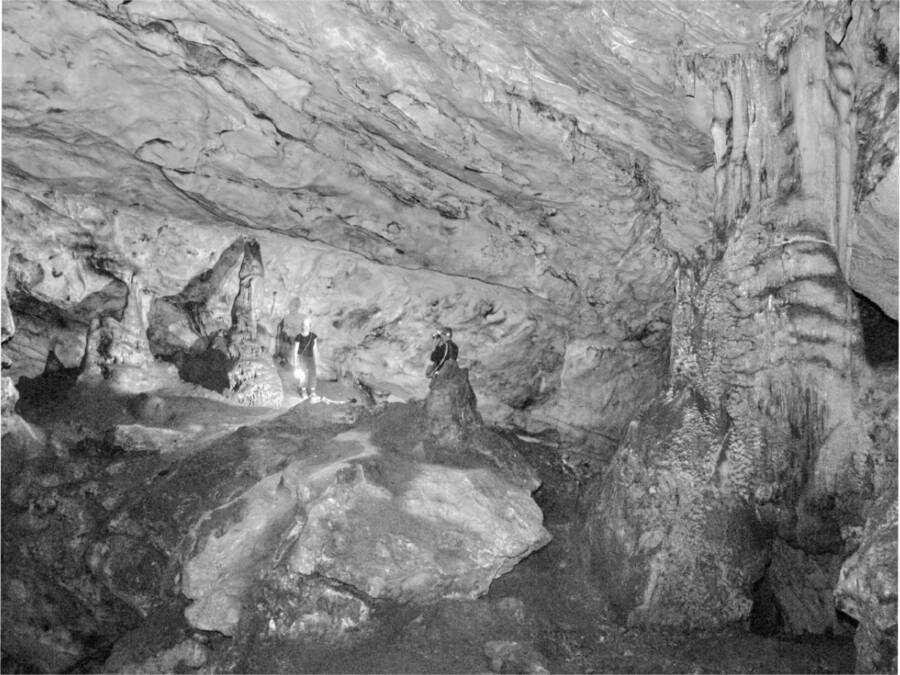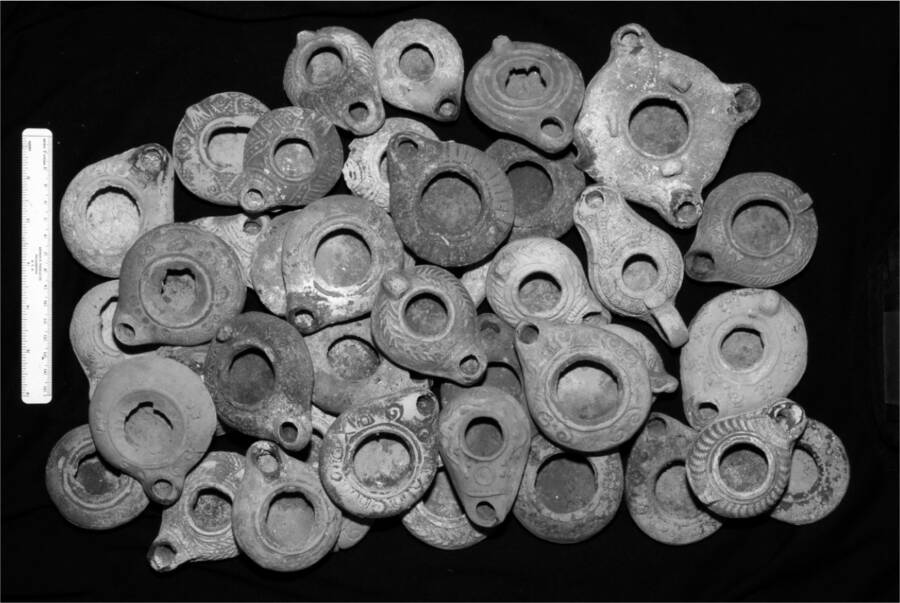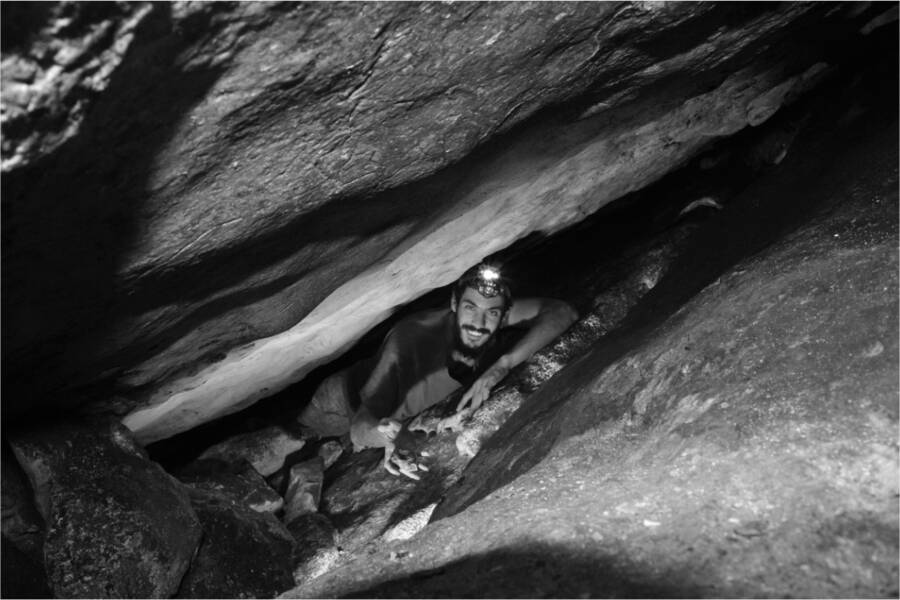Researchers uncovered a number of objects at Te'omim cave that indicate ancient necromantic ritual practices, including oil lamps and human skulls.

B. Zissu/Te’omim Cave Archaeological ProjectSeveral oil lamps and a portion of a human cranium extracted from the Te’omim cave near Jerusalem.
While excavating a cave near Jerusalem, researchers recently uncovered the remains of ancient human skulls, oil lamps, and spearheads. Now, they believe these artifacts may indicate that the site was used during the Roman era in rituals meant to communicate with the dead, a practice known as necromancy, or “death magic.”
According to a study published in the Harvard Theological Review, researchers believe these macabre rituals date back to between the second and fourth centuries C.E., in a cave just 20 miles west of Jerusalem known as the Te’omim cave.
The cave itself has served as the backdrop for numerous legends and real-life conflicts due to its natural spring water and large caverns. Visitors have travelled to Te’omim cave since at least the Chalcolithic period, and it served as a hideout for Jewish rebels during the Bar Kokhba revolt in the second century C.E.
Evidence now suggests that the cave also served as a site for necromantic pagan cult worship.
“The Te’omim Cave in the Jerusalem hills has all the cultic and physical elements necessary to serve as a possible portal to the underworld,” the researchers said in the study. “Most of the objects discovered in hard-to-reach crevices in the Te’omim Cave… were used in one way or another for sorcery and magic in caves perceived as possible portals to the underworld. Their purpose was to predict the future and conjure up the spirits of the dead.”

B. Zissu/Te’omim Cave Archaeological ProjectThe main hall of Te’omim cave.
Researchers discovered more than 100 ceramic oil lamps, but only three human skulls so far. Because of this, they hypothesize that the primary focus of the cultic ceremony revolved around depositing oil lamps for “chthonic forces” — forces inhabiting the underworld — possibly to attempt to raise the dead or predict the future.
The Romans considered necromancy to be evil and banned the practice throughout much of the Roman Empire. But speaking with Live Science, Boaz Zissu, study co-author and archaeologist at Bar-Ilan University in Israel, explained that many ancient cities had secret nearby “oracle” sites where people believed the line between the realms of the living and dead became blurred. Here, they would attempt to commune with the dead.
“There they found perfect conditions,” Zissu said. “it’s a bit remote, but not so far from the main road; it’s deep, but not very deep; and it has a deep shaft at the end that they regarded as a connection to the underworld.”
When researchers discovered the numerous artifacts at the site — including the human skulls, weapons, coins, and oil lamps — they found them tucked away in small crevices, suggesting that those who partook in these rituals intended to keep them a secret.

B. Zissu/Te’omim Cave Archaeological ProjectA collection of oil lamps recovered from the crevices of Te’omim cave.
Still, the researchers acknowledged that determining the precise nature of these magical practices is difficult when looking purely at the archaeological record.
“Identifying magical practices in the archaeological evidence is not simple,” they wrote in the study. “Magical practice is used in ritual acts that are undertaken, mainly by individuals, to achieve a desired effect. Sometimes the practices should be carried out in a specific location or require the use of specific material culture. Therefore, to locate magic in the archaeological context, we must trace material evidence for those practices.”
To further support their hypothesis, the researchers looked to classical literary sources and documentary evidence to identify items that were often used in magical rituals. The presence of human and animal bones, for example, indicates that the ritual intended to establish a connection to the deceased, and household items were often repurposed for magical use.
Oil lamps were a key component of necromantic practices as well. While they were certainly used for everyday purposes by the ancient Romans, the large quantity of oil lamps found at Te’omim cave can indicate a ritual context.

B. Zissu/Te’omim Cave Archaeological ProjectA member of the research team extracting oil lamps from a crevice between two boulders.
“The use of oil lamps for divination (lychnomancy or lampadomancy) was extremely widespread in the classical periods,” the researchers wrote. “The prophetic force behind the lamp was believed to be a spirit or spirits, or in some cases even gods or demons. Divination by means of oil lamps was done by watching the flame and interpreting the shapes created by the flame. A boy usually served as medium.”
Greek papyri and other classical literature frequently makes mention of the use of oil lamps for necromancy or speaking with the dead, sometimes including evocations to deities that ask them to speak through the lamp’s flames. Such examples can be found in the writings of Pliny the elder.
“In light of all this,” the researchers wrote, “we can propose with due caution that necromancy ceremonies took place in the Te’omim Cave in the Late Roman period, and that the cave may have served as a local oracle (nekyomanteion) for this purpose.”
While it may be impossible to know the full extent of the necromantic rituals that occurred in Te’omim cave, the researchers believe that this analysis of the items recovered from the site is “an outstanding test case worth examining within the developing discipline of the ‘archaeology of magic.'”
After learning about this ancient Roman necromancy ritual near Jerusalem, learn all about another recent discovery in Jerusalem — 2,500-year-old poop that contains the oldest evidence of dysentery. Or, read about the rare physical evidence of a Roman-era crucifixion discovered in a 1,900-year-old skeleton.





